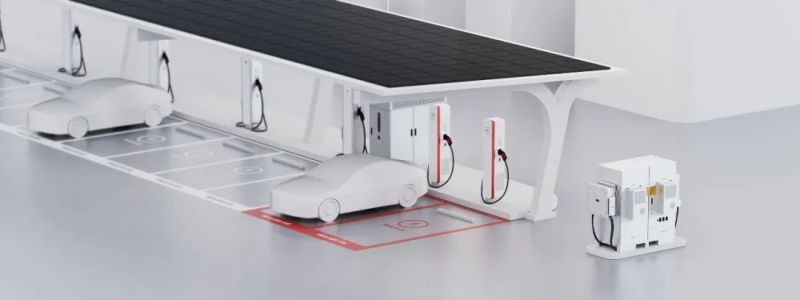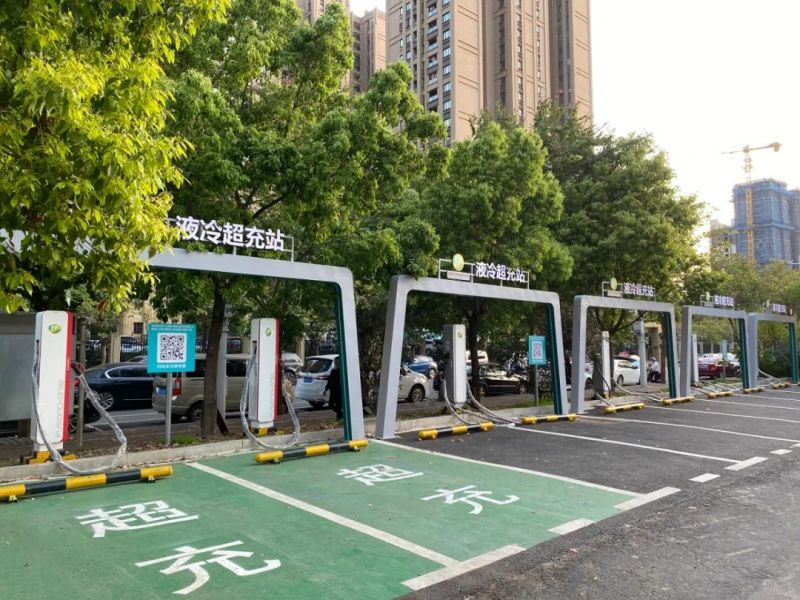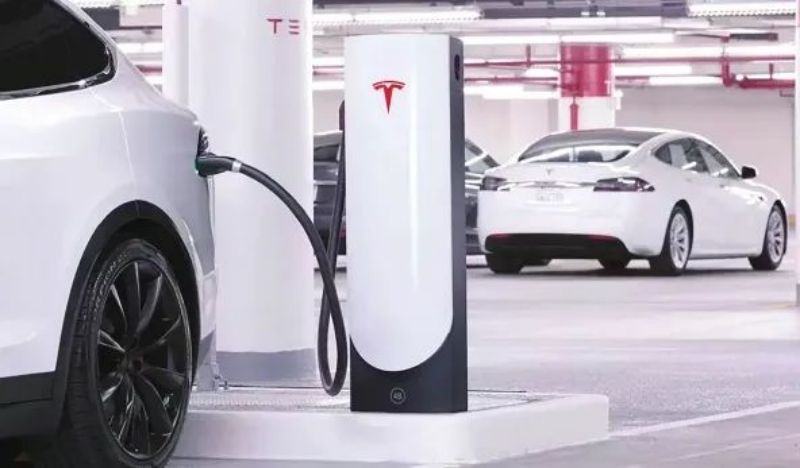“One kilometer per second and a driving range of 200 kilometers after 5 minutes of charging.” On February 27, at the 2024 Huawei China Digital Energy Partner Conference, Huawei Digital Energy Technology Co., Ltd. (hereinafter referred to as “Huawei Digital Energy”) released a fully liquid-cooled The supercharging station promotion plan claims to “make the refueling charging experience a reality.” According to the plan, Huawei Digital Energy will build more than 100,000 Huawei fully liquid-cooled supercharging piles in more than 340 cities and major highways across the country in 2024 to create “one network for cities”, “one network for high speeds” and “one power grid”. “Friendly” charging network. In fact, Huawei released a fully liquid-cooled supercharger product as early as October last year, and has completed the layout of multiple demonstration sites so far.
Coincidentally, NIO officially announced at the end of last year that it released a new 640kW fully liquid-cooled ultra-fast charging pile. The ultra-fast charging pile is equipped with a liquid-cooled charging gun that weighs only 2.4 kilograms and will be officially launched as soon as April this year. Up to now, many people have called 2024 the year of the explosion of fully liquid-cooled superchargers. Regarding this new thing, I think everyone still has many questions: What exactly is liquid-cooled overcharging? What are its unique advantages? Will liquid cooling become the mainstream development direction of supercharging in the future?
01
More efficient and faster charging
”So far, there is no unified standard definition for the so-called fully liquid-cooled supercharger.” Wei Dong, an engineer at the Microelectronics Technology Laboratory of Xi’an University of Technology, told a reporter from China Automotive News. In layman’s terms, fully liquid-cooled supercharger Pile charging is a technology that uses liquid circulation to quickly take away the heat generated during the charging process by key components such as charging modules, cables, and charging gun heads. It uses a dedicated power pump to drive the flow of coolant, thereby dissipating heat and allowing charging equipment to maintain efficient operation. The coolant in fully liquid-cooled supercharged piles is not ordinary water, but mostly contains ethylene glycol, water, additives and other substances. As for the proportion, it is the technical secret of each company. Coolant can not only improve the stability and cooling effect of the liquid, but also reduce corrosion and damage to the equipment. You must know that the heat dissipation method greatly affects the performance of charging equipment. According to theoretical calculations, the current heat loss of general high-power DC fast charging piles is about 5%. Without good heat dissipation, it will not only accelerate the aging of the equipment, but also lead to a high failure rate of charging equipment.
It is precisely with the support of full liquid cooling heat dissipation technology that the power of full liquid cooling super charging piles is much higher than that of conventional fast charging piles. For example, Huawei’s liquid-cooled supercharging pile has a maximum power of 600kW, allowing users to enjoy an extremely fast charging experience of “a cup of coffee and a full charge.” ”Although the current and power of fully liquid-cooled superchargers are different at present, they are all more powerful than conventional fast chargers and superchargers.” Zeng Xin, a professor at the University of Science and Technology Beijing, told a reporter from China Automotive News, At present, the power of ordinary fast charging piles is generally around 120kW, and conventional supercharging piles are around 300kW. The power of fully liquid-cooled supercharging piles from Huawei and NIO can reach up to 600kW. In addition, Huawei’s fully liquid-cooled supercharging pile also has intelligent identification and adaptive adjustment functions. It can automatically adjust the output power and current according to the rate requirements of the battery packs of different models, achieving a single charging success rate of up to 99%.
”The heating up of fully liquid-cooled supercharged piles has also driven the development of the entire industry chain.” According to Hu Fenglin, a researcher at the New Energy Innovation Technology Center of the Shenzhen Institute of Advanced Technology, the components required for fully liquid-cooled supercharged piles can be roughly divided into Overcharging equipment components, general structural components, high-voltage fast charging materials and other components, including intelligent sensing components, silicon carbide chips, power pumps, coolants, as well as fully liquid-cooled modules, fully liquid-cooled charging guns and charging Most of them have stricter performance requirements and higher costs than the components used in conventional charging piles.
02
Friendly to use, longer life cycle
Compared with ordinary charging piles and conventional fast/super charging piles, fully liquid-cooled super charging piles not only charge faster, but also have many advantages. ”The charging gun of Huawei’s fully liquid-cooled supercharger is very light, and even female car owners with little strength can use it easily, unlike previous charging guns that were bulky.” Zhou Xiang, an electric car owner in Chongqing, said.
”The application of a series of new technologies, new materials, and new concepts gives fully liquid-cooled supercharging piles advantages that conventional charging piles cannot match in the past.” Hu Fenglin said that for fully liquid-cooled supercharging piles, the current and power are more Big means faster charging. Normally, the heating of the charging cable is proportional to the square of the current. The greater the charging current, the greater the heating of the cable. To reduce the amount of heat generated by the cable and avoid overheating, the cross-sectional area of the wire must be increased, which means that the charging gun and charging cable are heavier. The fully liquid-cooled supercharger solves the heat dissipation problem and uses cables with smaller cross-sectional areas to ensure the transmission of larger currents. Therefore, the cables of fully liquid-cooled supercharging piles are thinner and lighter than those of conventional supercharging piles, and the charging guns are also lighter. For example, the charging gun of NIO’s fully liquid-cooled supercharging piles only weighs 2.4 kilograms, which is much lighter than conventional charging piles. The pile is much lighter and brings a better user experience, especially for female car owners, which is more convenient to use.
”The advantage of fully liquid-cooled supercharging piles is that they are safer.” Wei Dong said that in the past, most charging piles used natural cooling, air cooling and other methods, which required ventilation holes in relevant parts of the charging pile, which inevitably resulted in The air mixed with dust, even fine metal particles, salt spray and water vapor enters the interior of the charging pile and is adsorbed on the surface of electrical components, leading to problems such as reduced system insulation performance, poor heat dissipation, reduced charging efficiency, and shortened equipment life. In contrast, the full liquid cooling method can achieve full coverage, improve insulation and safety, and enable the charging pile to reach a higher level of dustproof and waterproof performance around the international electrical standard IP65, with higher reliability. Moreover, after abandoning the air-cooled multi-fan design, the operating noise of the fully liquid-cooled supercharging pile has been significantly reduced, from 70 decibels at the air-cooled charging pile to about 30 decibels, which is close to a whisper, avoiding the need for fast charging in residential areas in the past. There was an embarrassing situation of complaints due to loud noise at night.
Lower operating costs and shorter recovery cost cycles are also one of the advantages of fully liquid-cooled supercharged piles. Zeng Xin said that the traditional air-cooled charging piles generally have a lifespan of no more than 5 years, but the current lease periods for charging station operations are mostly 8 to 10 years, which means that at least reinvestment is required during the operation cycle of the station. Replace the primary charging device. The service life of fully liquid-cooled charging piles is generally more than 10 years. For example, the design life of Huawei’s fully liquid-cooled super charging piles is more than 15 years, which can cover the entire life cycle of the station. Moreover, compared with charging piles using air-cooled modules that require frequent opening of cabinets for dust removal and maintenance, fully liquid-cooled charging piles only need to be flushed after dust accumulates in the external radiator, making maintenance simple.
Taken together, the full life cycle cost of a fully liquid-cooled supercharger is lower than that of traditional air-cooled charging equipment. With the application and promotion of fully liquid-cooled super-charged piles, its comprehensive cost-effective advantages will become more and more obvious.
03
The market has bright prospects and competition heats up
In fact, with the continuous increase in the penetration rate of new energy vehicles and the rapid development of supporting infrastructure such as charging piles, fully liquid-cooled supercharging piles have become the focus of competition in the industry. Many new energy vehicle companies, charging pile companies, technology companies, etc. have begun technological research and development and layout of fully liquid-cooled supercharging piles.
Tesla is the first car company in the industry to deploy liquid-cooled supercharging piles in batches. Its V3 supercharging piles adopt a fully liquid-cooled design, liquid-cooled charging modules and liquid-cooled charging guns. The maximum charging power of a single gun is 250kW. It is reported that Tesla has gradually deployed new V4 fully liquid-cooled supercharging stations around the world since last year. Asia’s first V4 supercharging station was launched in Hong Kong, China, in October last year, and will soon enter the mainland market. It is reported that the theoretical maximum charging power of this charging pile is 615kW, which is equivalent to the performance of Huawei and NIO’s fully liquid-cooled supercharging piles. It seems that the market competition for fully liquid-cooled charging piles has quietly begun.
”Generally speaking, fully liquid-cooled superchargers have high-power charging capabilities, and the charging efficiency is greatly improved, which can effectively alleviate users’ charging anxiety.” In an interview with a reporter from China Automotive News, he said, however, currently fully liquid-cooled superchargers Overcharging piles are limited in application scale, resulting in higher costs. Moreover, since high-power charging requires optimizing power battery safety management and increasing the vehicle voltage platform, the cost will also increase by 15% to 20%. Overall, the development of high-power charging technology requires comprehensive consideration of factors such as vehicle safety management, independent controllability of high-voltage devices, and cost. This is a step-by-step process.
”The higher cost of liquid-cooled supercharging piles is one of the practical obstacles hindering its large-scale promotion.” Hu Fenglin said that the current cost of each Huawei supercharging pile is about 600,000 yuan. At this stage, small and medium-sized enterprises generally engaged in the charging business It’s almost hard to compete. However, in the long-term development prospects, with the expansion of applications and the reduction of costs, the many advantages of fully liquid-cooled supercharged piles will gradually become prominent. The rigid demand of users and the market for safe, high-speed and fast charging will bring broader space for the development of fully liquid-cooled supercharging piles.
A recent research report released by CICC pointed out that liquid cooling overcharging drives the upgrade of the industrial chain, and the domestic market size is expected to reach nearly 9 billion yuan in 2026. Driven by car companies, energy companies, etc., it is initially expected that the number of domestic liquid-cooled supercharging stations will reach 45,000 in 2026.
Zeng Xin also pointed out that in 2021, there will be less than 10 models in the domestic market that support overcharging; in 2023, there will be more than 140 models that support overcharging, and there will be more in the future. This is not only a realistic reflection of the accelerated pace of people’s work and life in replenishing energy for new energy vehicles, but also reflects the development trend of market demand. Because of this, the development prospects of fully liquid-cooled super-charging piles are so promising.
Post time: Mar-15-2024





